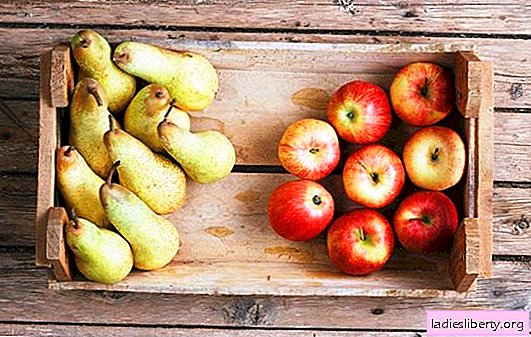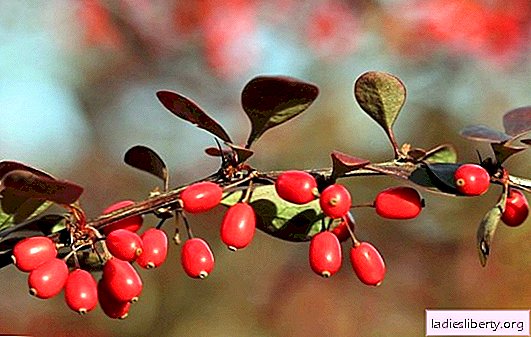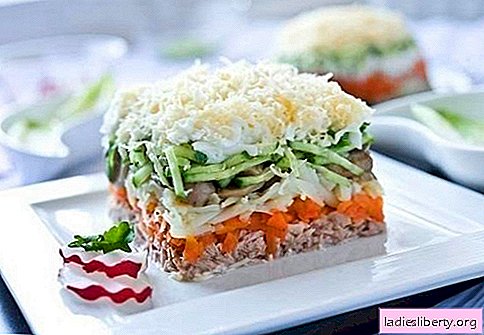
There is a big difference between compote and a drink in a plastic bottle.
Therefore, you need to choose compote in any of its variations and teach modern children from the cradle to this old Russian drink, distracting them from Pepsi, forfeit and other fluids with elements present in the brake fluid and dry cleaning products in any way.
If you cook stewed fruit - it is lazy and easier to buy a bottle of Pepsi-Cola, read at your leisure what this name means in literal translation into Russian - the two components that make up the name and the drink are plants containing narcotic substances.
Is this not a reason to change habits and return to simple recipes for drinks of Slavic cuisine, where the benefit is in every drop.
Stewed apples and pears for the winter - basic technological principles
According to the rules of technology, the ratio of water, sugar and fruit in the compote should be approximately the same. This applies to large production lines. It is not necessary to comply with such strict requirements in home canning, so each housewife should be guided by their own criteria for choosing a compote of apples and pears for the winter.
Let's remember what troubles most do not like when canning.
• When most of the glass jars have already been spent on preserving cucumbers, tomatoes, squash caviar and dough, you have to think about where else to get empty containers, but it costs a lot.
This problem can be solved with the help of recipes for concentrated stewed apples and pears for the winter. Reduce the amount of water in the jar to a minimum volume, filling it to the top with fruits and thick syrup. Water can be added in the winter by opening the can and bringing to boiling its contents with the right amount of water. This technique can reduce the consumption of containers for preservation of compote. Concentrates will also allow you to conveniently place the jars in the pantry, and there will still be a lot of free space.
• If you are embarrassed by the high cost of sugar, which in the season of harvesting already strains the family budget - close the compote of apples and pears for the winter completely without sugar. In this recipe, in addition to saving money in the summer, there are several advantages. A sugar-free drink contains a minimum of calories and therefore can be consumed even while dieting. Sugar, if desired, can be added before consumption. Fruits and berries contain a sufficient amount of natural acid, which will help the compote in the jar to be perfectly preserved. Sugar, as a preservative, in such cases, the component is optional.
• If you have to buy canned fruits at the market, for lack of your own orchard, then remember how much are the drinks that you will buy all the same all the year, and at the same time approximately calculate the cost of medicines for the prevention or treatment of gastritis, ulcers and other troubles associated with the use of "food chemistry". In addition, fruits are even more expensive in winter, and vitamins are still needed.
• Those housewives who cannot stand the heat in the kitchen during pasteurization can easily learn the methods of preservation that exclude this tedious process - preserve by double or triple pouring without pasteurization, and add citric acid to be sure before rolling. Cans, if thoroughly cleaned with baking soda and rinsed with boiling water, can also not be sterilized. Or disinfect them after regular microwave washing. As the saying goes, "the wolves are full, and the sheep are safe."
• Do not want to bother with slicing fruit for a long time - cover it whole. Compote is an improvisation. Whole fruits in winter can be caramelized and decorated with dessert so that friends will ask for a “recipe” for an ordinary biscuit or sweet curd mass. And from the liquid part of the compote, you can cook jelly, syrup, make jelly.
There are no strict standards for bookmarking compote products. Compote is a drink that cannot be spoiled. The only task when cooking it is to preserve vitamins.
And a little about raw materials for compote from apples and pears for the winter. Most often, in home preservation, those varieties of fruits that grow on a tree, or from those that were able to buy cheaper, are used at a wholesale price - immediately, for jam, jam and compote of apples and pears for the winter.
In accordance with industrial technologies, for example, the White filling apple variety is not recommended for processing, since its flesh is loose and boils as a result of heat treatment. But these recommendations have nothing to do with home technologies, because if the tree grows in the garden, and there are no other varieties nearby, then you can also make compote from it for the winter. Just pick apples from the tree half-ripe, while they are hard, and overripe fruits, just come in handy for jam. The density of fruits should be especially taken into account if they are cut into slices for compote. The finer the slicing, the denser the fruits should be, so that after pasteurization they do not turn into a puree mass.
That's all the wisdom, except that apples and pears are very suitable for cinnamon, vanilla, cardamom (for baking duck or turkey), fresh mint leaves. These are original recipes of compote from apples and pears for the winter, "with a twist." Creativity is one of the basics of cooking.
Recipe 1. Stewed apples and pears for the winter, sugar free
Raw Material:
Garden apples
Forest pears
Water
Cooking:
For compote, select garden apples, sweet varieties, technical ripeness, and wild, forest pears. Before slicing the fruits, let them stand in cold salted water for 2-3 hours: the salt will help to “expel” fruit pests, and if the fruits were bought on the market, pre-soaking will exclude the presence of pesticides.
Prepare sterile jars and lids. Cut the fruit into slices, removing the core and the stalk. Boil water in a large saucepan and blanch the slices together for 2-3 minutes. Then put them in jars to the top. Pour in the water in which the fruit was blanched, cover the banks with lids. When cooled to 40 ° C, drain the water into the pan again, boil and pour again. The third time after the water boils, add a little citric acid (to taste). Immediately pour the compote into cans and roll up the lids.
Opening cans with a compote of apples and pears in winter, sugar can be added to taste. Fruits in such a compote will remain intact and retain the aroma of summer, and even such a compote can be consumed with diets, as well as patients with diabetes mellitus.
Recipe 2. Stewed apples and pears for the winter, from whole fruits
Composition:
White filling
Pear "Lemon", summer
Sugar Syrup (Ready)
Cooking:
Take small fruits of apples and pears, technical ripeness, without any signs of damage. Soak them in water, wash and remove the stalks. Tightly packed in prepared sterile jars, pour the fruits with boiling water, soak them for half an hour. Drain the pot and add the same amount of sugar. Cook the syrup until “thick string”. Note that after boiling, the volume of syrup that needs to be filled with fruits will decrease, so add water immediately, before boiling the syrup - the excess can be used for other preservation recipes. In the process of cooking the syrup, remove the foam - it is necessary that the syrup is transparent, and five minutes before the end of cooking add a solution of citric acid (2 g per liter of syrup). Pour fruit in jars in boiling syrup, and immediately roll up. Wrap the jars with a blanket and hold until cool.
Such a concentrated compote can be used to make drinks and desserts in winter.
Recipe 3. Stewed apples and pears for the winter with raspberry syrup - maseduan
Composition on the jar (3l):
Raspberry syrup 30%
Apples and pears (peeled slices) 40%
Water
Cooking:
Prepare apples and pears as described in recipe No. 1, but peel the fruits first. Place the slices in sterile jars, filling them in 1/3 of the volume. Add the same amount of raspberry syrup to boiling water, boil for 5 minutes and pour fruit.
Place the jars immediately in a water bath and sterilize. For cans with a capacity of 1.0 l, sterilization time - 10 minutes, 2.0-3.0 l - 15 minutes.
After sterilization, immediately cork and turn upside down until it cools.
Recipe 4. Stewed apples and pears for the winter in prune syrup
Raw Material:
Pitted prunes 20%
Water 40%
Sugar 10%
Apples and pears of autumn varieties (1: 1) 30%
Cooking:
Put peeled and sliced apple and pear slices with hard flesh into prepared sterile jars. Fill 1/3 of the volume with them. From sugar and prunes, cook the compote, as usual. Let it brew, strain and fill them with cans.
Sterilize the compote, immediately roll up the jars and turn over until cool.
Recipe 5. Stewed apples and pears for the winter with vanilla
Raw Material:
Invert Syrup 3 parts
Fruit, sliced (apples and pears) 30%
Vanilla (to taste)
Water 4 parts
Cooking:
With prepared slices of pears and apples, fill the jars, half the volume or a little less. Add vanilla and syrup to boiling water, mix, and after 2-3 minutes pour the contents of the cans with it. Cover the jars with lids and pasteurize for 10-15 minutes. Seal immediately after pasteurization, and turn the jars upside down.
Recipe 6. Stewed apples and pears for the winter - a boil with wild rose on honey
Products:
Rosehip 200 g
Honey 400 g
Dried fruits: apples, prunes and pears - 300 g
Water 3 L
Cooking:
An ancient recipe for ancestors is a blast. It was cooked for the holidays, served on the table on Christmas Eve, with the hope of well-being, and honey was definitely added to it. Of course, honey and dried fruit compote can be cooked at any time, and for this it is not necessary to preserve it in jars, but there is one subtlety: the more it is infused, the tastier.
Gather rose hips after the first frost, or use dried berries. Wash dried fruits, fill with cold water and cook over low heat, from the moment of boiling - 5-10 minutes. Add honey and after five minutes pour into hot sterile jars. Cork without pasteurization.
Stewed apples and pears for the winter - useful tips and tricks
For canning, try to select fruits of the same degree of maturity, so that after sterilization they retain their shape and the same consistency. More ripe fruits may be boiled after sterilization. For the same reason, whole fruits are sorted by size before laying in jars.
It's no secret that gardens are treated with pesticides to control pests. Therefore, fruits purchased on the market must be kept in water before processing to prevent pesticides from entering canned beverages.











